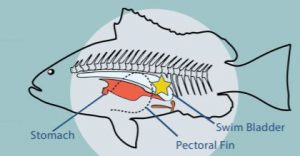Being neutrally buoyant, or weightless in the water, allows fish to minimize the energy expenditure required to stay at a particular depth to feed, hide, reproduce or migrate. For a fish to be buoyant, it must displace an equal or greater amount of water than its own body mass. This is accomplished using a gas-filled organ, called the swim bladder.
Swim Bladder Basics
A swim bladder is basically like a balloon that expands and contracts depending upon how much air is inside. This balloon-like swim bladder allows fish to maintain precise control of buoyancy, because the volume of gas they contain can be regulated quite easily. When the swim bladder expands it increases in volume and therefore displaces more water. This increases the fish’s buoyancy, causing it to float upward. When the swim bladder deflates, the fish’s buoyancy decreases, causing it to sink as it displaces less water.

Swim bladders are located in the upper body cavity, below the spine, and develop as an outgrowth or pouch of the gut. Swim bladders are of two basic types. An ‘open’ swim bladder (Physostomous) is connected, via a pneumatic duct, to the gut. Fish with this type of swim bladder, herrings for instance, must gulp air at the surface to inflate the swim bladder, and then burp or fart air to deflate it. Occasionally you may have seen fish come to the surface and gulp air; this is how fish like tarpon and gars get air into their open swim bladders. In a ‘closed’ swim bladder (Physoclistous), the connection to the gut is only present during the larval stages. At least two-thirds of all modern fish have a closed swim bladder. For fish with a closed swim bladder, gas exchange for inflation and deflation is controlled by secretion or absorption of gases from blood vessels.
How it Works
Swim bladder volume follows a principle known as Boyle’s law which says pressure at the surface is 1 atmosphere (atm) and increases by 1 atm, or 14.7 pounds per square inch, for every 33 feet of descent. So, a fish swimming at the surface is subject to 1 atm of pressure. At 33 feet the pressure increases to 2 atm, resulting in compression of the swim bladder to half its original surface volume. This causes the fish to become heavier than the water around it allowing for descent. To return to the surface, the swim bladder must be inflated to its original volume because returning to the surface decreases the pressure in the swim bladder by half.
Because fish with an open swim bladder must gulp air, they are generally restricted to shallow water or surface waters. If a fish with an open swim bladder, herring or sturgeon for instance, were to stay neutrally buoyant below 33 feet, it would need to fill the gas bladder to above two atmospheres, which could not be accomplished through the pneumatic duct. At greater depths the swim bladders of these fish will collapse, resulting in the fish becoming negatively buoyant. This is probably why so many modern fish evolved to having a closed swim bladder.
Fish with closed swim bladders are better suited to all water column and bottom water depths, but rapid ascent can still pose problems. A few fish with closed swim bladders, Amberjacks for example, have a specialized purge valve in the gill cover area that allows them to burp or fizz gas on rapid ascent. This allows them to rapidly move throughout the entire water column. However, most reef fish cannot deflate their swim bladders quick enough to offset the pressure changes during rapid ascent, such as capture with hook and line. Because of this, reef fish – groupers and snappers for instance – taken from deep water, often experience swim bladder trauma, referred to as barotrauma.
Swim Bladder Trauma
Signs of barotrauma include a swollen abdomen, bulging eyes, and the stomach everted through the mouth. Research findings indicate that the survival of fish experiencing barotrauma can be significantly increased using a variety of methods that quickly return the fish to depth while minimizing injury. Visit www.catchandrelease.org to learn more about methods to help released fish experiencing barotrauma survive.
Some Fish Don’t Have Swim Bladders
Of course, not all fish even have a swim bladder. Sharks, flounder, cobia, and mackerel, do not have a swim bladder and as a result, sink when they stop swimming. These fish can only maintain their position in the water column through active swimming. Sharks also have large livers which hold a lot of fat (lipids), and this creates some level of buoyancy control as well. But for flounders, most of the time, buoyancy is just simply overrated. In their world, life is just fine, lying around, camouflaged in the bottom sediments.
Fish show a range of strategies for buoyancy control, and the swim bladder is an important organ that allows fish to save energy and control their position in the water column. Understanding the types of swim bladders and adaptations for buoyancy control is important for fisheries scientists and anglers alike.
 6
6
